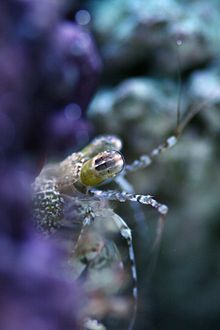

In the compound eye of invertebrates such as insects and crustaceans, the pseudopupil appears as a dark spot which moves across the eye as the animal is rotated.[1] This occurs because the ommatidia that one observes "head-on" (along their optical axes) absorb the incident light, while those to one side reflect it.[2] The pseudopupil therefore reveals which ommatidia are aligned with the axis along which the observer is viewing.[2]
- ^ M. F. Land; G. Gibson; J. Horwood; J. Zeil (1999). "Fundamental differences in the optical structure of the eyes of nocturnal and diurnal mosquitoes" (PDF). Journal of Comparative Physiology A. 185 (1): 91–103. doi:10.1007/s003590050369. S2CID 9114187. Archived from the original (PDF) on 2016-03-04. Retrieved 2008-07-27.
- ^ a b Jochen Zeil & Maha M. Al-Mutairi (1996). "Variations in the optical properties of the compound eyes of Uca lactea annulipes" (PDF). The Journal of Experimental Biology. 199 (7): 1569–1577. PMID 9319471.